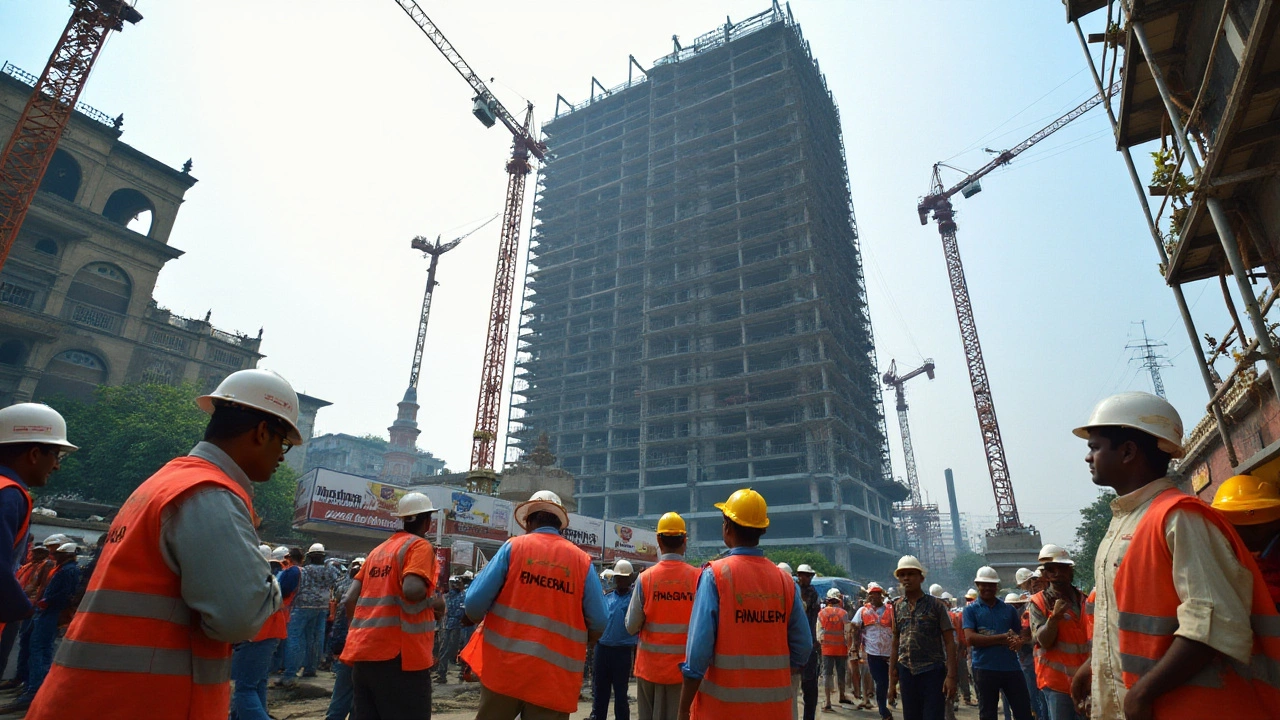Top Construction Giants: Unveiling the Biggest Players of 2024

The construction industry is an ever-evolving landscape that caters to various sectors, including residential, commercial, and infrastructure projects. In 2024, leadership in this field is defined not just by the size of buildings, but also by a company's global footprint and technical ingenuity. As we uncover the biggest construction companies of today, it becomes apparent that these titans are not only shaping skylines but are also setting benchmarks in sustainability and technological advancement.
Identifying the largest players in construction isn't simply about the size of their projects. It's about their influence, their innovation, and how they anticipate and react to the challenges of modern construction. This article will take a closer look at the companies that are driving this change, each with their unique contributions and vision for the future of building.
- Introduction to Global Construction Giants
- Criteria Defining the Biggest Companies
- Top Companies and Their Landmark Projects
- Innovations and Technologies in Construction
- Future Prospects and Industry Impact
Introduction to Global Construction Giants
In the sprawling realm of the construction industry, few names reverberate with as much weight as the global construction giants of today. These companies are not merely defined by the vastness of their projects or the skyscrapers they build; they embody a forward-thinking approach that melds innovative technologies with sustainable practices. As we cast our eyes across the globe, it becomes evident that these leaders in construction companies are seamlessly integrating technology such as Building Information Modeling (BIM) and modular construction into their workflows, setting new standards for efficiency and environmental consciousness.
The intriguing aspect of these giants isn't just their construction prowess; it's their ability to navigate the intricate web of modern demands. This includes catering to escalating urbanization while minimizing their ecological footprint. For instance, Bouygues Construction has taken significant strides in eco-friendly construction by adopting low-carbon concrete. Meanwhile, companies like Bechtel are implementing digital twin technology to improve project outcomes, echoing their commitment to innovation. A testament to their impact, a recent study showed that the 10 largest construction firms influence more than 50% of global construction GDP as they spearhead developments across continents.
Indeed, what truly sets these colossal firms apart is their resilience in the face of global adversities, be it economic upheaval or a pandemic. Many of these companies have demonstrated an extraordinary capacity to adapt, pivoting their strategies to embrace new market realities. With projects like Beijing Daxing International Airport and the London Crossrail, these giants showcase remarkable flexibility and scope. As Pericles Venizelos, CEO of a top global firm, once noted,
"The future of construction will be defined by how well we balance growth with sustainability and technological progress."This notion defines the essence of the modern construction giant: a blend of tradition, innovation, and a profound understanding of global needs.
Criteria Defining the Biggest Companies
When it comes to identifying the largest construction companies in the world, several criteria come into play beyond mere revenue. While financial prowess is undeniably significant, it is the intricacy of their projects, their innovation in technology, and their ability to influence and shape modern infrastructure that sets them apart. These criteria serve as valuable indicators, helping industry experts and enthusiasts alike to gauge who the true leaders are in the construction arena.
Firstly, one of the most prominent factors is a company's geographical reach and the diversity of its operations. Leading firms often operate on a global scale, managing projects across multiple continents. This geographic diversity not only spreads their impact but also shows the company’s ability to meet diverse architectural standards and regulations, which is no small feat. Such adaptability is crucial for establishing a stronghold in the global construction industry.
A company's portfolio is another telling factor. It encompasses the magnitude and complexity of their completed and ongoing projects. Whether they're building state-of-the-art skyscrapers or transformative infrastructure like bridges and tunnels, these projects reflect the company’s technical expertise and innovation. Often, these companies are involved in some of the world's most iconic structures, becoming landmarks in their own right.
Innovation has also become a critical factor in determining the largest players in this field. Advanced construction technologies such as Building Information Modeling (BIM), drones for surveying, and prefabrication techniques are reshaping the landscape. Companies that invest in these areas not only gain a technological edge but are also able to deliver more efficient and sustainable projects. As the sector navigates the challenges of climate change, those committed to sustainable building practices are gaining prominence and recognition.
"The use of cutting-edge technology in construction is no longer a luxury, but a necessity," notes John Smith, a leading expert in construction technology. "It separates the leaders in the industry from the rest, driving efficiency and sustainability."
Lastly, the financial stability and strategic vision of a company also play crucial roles. A robust financial foundation allows firms to undertake large-scale projects without faltering, while a clear strategic vision ensures their longevity and success. These companies often engage in strategic partnerships and mergers, expanding their capabilities and reinforcing their market positions. In essence, the true behemoths of the construction world are those who excel in these diverse yet interconnected areas, demonstrating a balance of financial might, operational excellence, and innovative foresight.

Top Companies and Their Landmark Projects
In the vibrant tapestry of the construction industry, a few companies have established a reputation for their pioneering projects or, shall we say, their audacious architectural wonders. Their works do not merely exist to serve commercial or residential purposes but rather reshape skylines and push architectural boundaries. Among these giants, the Chinese multinational China State Construction Engineering Corporation (CSCEC) stands unparalleled as of 2024. Renowned for its awe-inspiring endeavors, CSCEC has left indelible marks on major cities globally, most notably with the construction of the Bahrain Bay infrastructure project, which exemplifies ingenuity in urban design. This project included innovative residential, commercial, and retail spaces beautifully integrated with green technology, a model for sustainable urbanization.
Meanwhile, Bechtel Corporation of the United States has not sat idle. Known for its pivotal role in landmark projects such as the Crossrail in London, Bechtel has continued to pioneer infrastructure development. Their recent undertaking, the Riyadh Metro, has showcased how collaboration with local governments can transform a city's transportation landscape. Spanning six metro lines and nearly 176 kilometers, this project promises to change daily commutes for millions, marking a significant stride in public infrastructure. Their dedication to integrating state-of-the-art technology with everyday functionality for large-scale urban environments remains a hallmark of Bechtel's global standing.
Another beacon in the industry, Vinci, a French entity, has made spectacular contributions with projects like the Grand Paris Express, the largest urban transport project in Europe. This initiative aims to revolutionize public transport by extending the city's metro system by 200 kilometers. It demonstrates Vinci's competence in managing complex logistical challenges, enhancing urban connectivity. It's a testament to their focus on sustainable growth, economic potency, and climate resilience through construction.
Amidst these concrete marvels, Skanska, a Swedish company, keeps pushing forward green building practices. Their innovative approach is manifest in Norway’s Powerhouse Brattørkaia, a world-leading energy-positive building, producing more energy than it consumes while also serving as a beacon of modern energy-efficient architecture. This project utilizes solar, wind, and geothermal energy, highlighting how a blend of tradition and technology can lead toward ecological construction solutions. According to the company's press release, "We aim to inspire the entire construction market with sustainable solutions."
These top construction companies often share a common thread: an unwavering commitment to integrating technology with creativity. They rely on the prowess of teams that thread the needle between practicality and possibility in construction. Their combined adeptness not only results in the efficient realization of ambitious projects but also drives the industry to continuously explore new frontiers. From infrastructure to iconic buildings — these companies are stroking the canvas of the world's future urban landscapes, one brick at a time.
Innovations and Technologies in Construction
Construction today moves rapidly with a wave of new technologies influencing every phase, from planning to execution. The integration of Artificial Intelligence in the construction sector is particularly noteworthy. With AI, firms can predict project risks more effectively, optimize labor schedules, and even foresee material shortages. This allows construction companies to manage resources better, minimize delays, and cut costs. AI-powered tools are quickly becoming indispensable in the industry's toolbox. Another vital area where technology has made a remarkable impact is Building Information Modeling, or BIM. BIM software enables builders to create digital representations of their projects, providing comprehensive insights into the design process. This helps teams coordinate more effectively and spot potential issues before they become costly errors, drastically improving efficiency. Innovations such as these underscore the importance of digital transformation in the construction landscape.
Another significant technological advancement is the use of drones for surveying and inspection purposes. Drones equipped with high-resolution cameras can capture expansive views of sites, providing critical data that was once labor-intensive and time-consuming to acquire. This not only expedites processes but also enhances precision in project planning. Advanced robotics also find increasing prominence on construction sites. Robots can perform repetitive tasks with high accuracy and can take on dangerous duties, reducing the risk of human injuries. This does not replace human workers but rather enhances their ability to focus on more complex tasks, pushing productivity upward. The role of 3D printing also can't be overlooked. Whether creating models or printing components directly onsite, this technology reduces waste and speeds up construction phases. A senior analyst at a tech firm remarked,
“Technology isn't just an added tool for construction companies — it's reshaping how they operate.”Embracing these technologies ultimately enables firms to take on larger projects, maintains their global footprint, and ensures competitive advantage.
Green construction technology is gaining traction too, with eco-friendly materials and sustainable building practices taking center stage. Construction companies are increasingly focusing on reducing carbon footprint by using renewable energy sources or incorporating smart energy systems within buildings. Solar panels, energy-efficient HVAC systems, and window glazing technologies contribute to this eco-friendly movement. Such initiatives not only aim to preserve the environment but also cater to the burgeoning consumer demand for sustainable buildings. Modern construction also benefits from blockchain technology. Secure, transparent, and efficient, blockchain fundamentally changes how contracts are handled, aiding in contract management and ensuring data integrity. These technological innovations help construction firms maintain a strong footing in a highly competitive and ever-evolving global market.

Future Prospects and Industry Impact
As we look towards the future, the landscape of the construction industry appears significantly promising yet laden with transformative potential. The biggest construction companies are not only levering technological advances to push the envelope when it comes to efficiency and sustainability but are also deeply involved in shaping policies and standards that will define the future of building. These firms are stepping beyond traditional methods, integrating artificial intelligence, robotics, and green building technologies that promise to revolutionize how we construct the world around us. The immediate future sees greater emphasis on reducing carbon footprints, where the adoption of renewable energy sources and materials with lower environmental impact is paramount.
The impact of these advancements is profound. Major players in the sector are investing heavily in research and development, seeking not only to cut costs and timeframes but also to enhance the safety and sustainability of construction processes. The shift towards prefabrication and modular construction is gaining ground, which dramatically reduces waste and increases efficiency. According to a report by McKinsey & Company, modular construction can speed up build time by 50% and cut costs by a noteworthy 20%, setting a new standard for urban development. This trend is expected to continue, providing a massive opportunity for top construction firms to redefine architectural norms and client expectations.
Moreover, the embrace of digital tools such as Building Information Modeling (BIM) is transforming project management and collaboration across the industry. These technologies are crucial in improving precision and reducing errors that often lead to costly overruns. This integrated approach is sparking a renewed interest from investors and stakeholders eager to be part of these groundbreaking advancements.
"The key to future success in construction lies not only in adopting new technologies but also in fostering a culture of collaboration and innovation across the value chain," says Jorge Lopez, a noted industry analyst.With such prospects, the construction sector's future is soon to be dictated by those who can innovate and adapt at breakneck speeds.
Additionally, the global construction companies are increasingly focusing on smart cities and infrastructure projects that are aligned with urbanization and digital transformation trends. As urban populations swell, the demand for efficient, scalable, and technologically integrated infrastructures will rise exponentially. A compelling example is the rise of autonomous buildings and AI-driven systems that will provide seamless operations of facilities. These futuristic urban centers promise improved quality of life through advanced services in public safety, transportation, and utilities—an ambitious vision that construction companies are keenly developing.
The challenges of climate change and resource scarcity are additional factors pushing construction firms to innovate. The emphasis on sustainable practices not only helps in preserving the environment but also places these companies at the forefront of fulfilling international agreements aimed at reducing global emissions. It's expected that by 2030, the construction sector will play a pivotal role in achieving global climate goals through their choice of materials and construction techniques that align with circular economy principles. This holistic transformation, deeply embedded within the industry, suggests a ripple effect that will influence global economies and societies at large, making the prowess and responsibility of the construction industry ever more critical.

